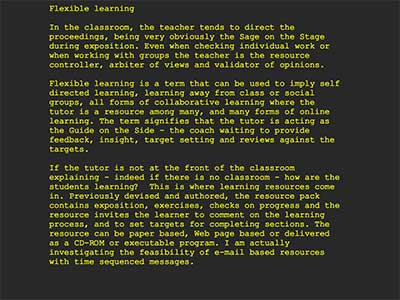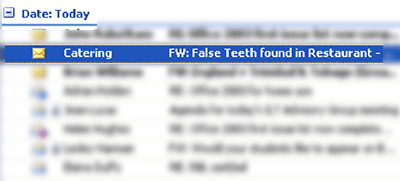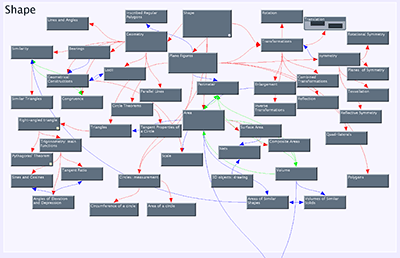July 4th, 2006
Charles Nelson has posted a note about my GCSE Maths project in his ESOL blog Explorations in Learning. Nelson is publishing his blog using Tinderbox and Flint, the blogging assistant provided by Eastgate Systems. I personally will need to continue to use WordPress as I publish from multiple locations.
I am flattered by the attention from a total stranger who seems to understand what I am on about, but I am also waging something of a campaign to convince the authors of Tinderbox of the need to be able to access the names of links between notes in HTML templates (and to produce lists of incoming and outgoing links sorted by and headed with the link name for a given note without ‘hard wiring’ specific link type names in the HTML template).
Of course, I could hard wire text links between notes, and given the modest scale of what I’m producing that might be the easiest method.
Perhaps I’m asking a little much for bespoke software where the main focus is sorting notes by attributes using agents – and getting blogs published.
Posted in Notes | No Comments »
July 4th, 2006
Posted in Photos | Comments Off
July 3rd, 2006

WriteRoom by Hog Bay Software is a simple text editor (ascii, no styled text) for Mac OS X that can be used in a genuine full screen mode. The idea is that you can JustWriteTM, no distractions from iTunes, e-mail, RSS feeds or for those of you that indulge, the instant messenger application.
I’m keeping it around for note taking and brainstorming, but I still have the AlphaSmart with its 400 hour battery life…
Posted in ILT, Notes | Comments Off
July 2nd, 2006

Most of us have one College email account, and I find that email has replaced internal memos and notices to a large degree.
Many Web sites require an email address to gain access to features, mailing lists, marketing information. Spam might happen. I use a googlemail account to sign up on Web sites to try to cut down the noise on the College account.
Good news: ‘Plus addressing’ is a way that you can add a ‘tag’ to your email address when signing up on a Web site that will allow you to track which emails came as a result of a given Web page form. If your address is fred@gmail.com, you sign up with the address fred+gardening@gmail.com. Then if spam starts arriving with the ‘to’ field fred+gardening@gmail.com you know which list got leaked, and you can set up a spam rule to block mail addressed to the full address with the plus tag. By using different tags for each Web form, you can keep control of which automatically generated mail you want to see.
How it works: ‘Old school’ mail servers ignore everything from the +sign to just before the @ sign in the address. They route the mail to the mailbox with name matching the first part of the address.
Bad news: MS based mail servers bounce emails addressed to an address with a plus tag – you will never see them. Some Web forms check that email addresses are ‘valid’ based on the characters you type in. Some are designed to reject plus addressing as not valid, so you will not be able to use a plus address when signing up.
Posted in ILT | Comments Off
July 1st, 2006
Posted in Photos | Comments Off
June 29th, 2006

Eastgate Systems Tinderbox is a note taking application for Mac OS X (and soon, Windows). The application has just been upgraded to Version 3.5 with significant improvements in the user interface and and the addition of features of interest to bloggers. The application allows you to record ideas in small bits called notes and then re-arrange the bits as structures and relationships begin to emerge. In this sense the application is an ‘upside down outliner’. Each note can be opened in a word-processor like window that can accept bitmap graphics as well as styled text. Notes can be viewed in a variety of ways including Map View, a visual array of notes, and in Outline View, a more traditional list by title.
My hope and summer project is that by refactoring the Maths topics ruthlessly, I can get to a set of small hard nuggets of Maths (a sort of irreducible set of base vectors) that can be rearranged and strung together in different combinations to suit the learning styles of all the various students we see at College. To continue the analogy with Extreme Programming, I hope to associate a class time factor with each note so that you can ‘price’ a route through a topic quickly.
Some months ago I brainstormed topics in GCSE Intermediate Maths with students and a selection of textbooks. I am now beginning to group the grains together and establish links between the topics. So far we have a mind map for the Shape module with three different kinds of link:
- A contains B (red)
- A is related to B (blue)
- A contrasts with B (snot green – the colors can be customised)
Soon I will be able to add a fourth kind of link – StudyNext – that will provide a thread through the material. Perhaps there will be a number of threads to suit different learning styles.
A major feature of Tinderbox is the provision of export templates – you can turn a web of notes into a set of interlinked Web pages by defining one or more templates. Notes have attributes – as many as you wish to define – and agents can collect sets of notes according to the values of attributes to index notes in many ways. At present links to the note/page and links from the note/page can be listed but it is not possible to export information about the type of link to the Web pages; I hope link types are added to the export tags in a future release.
My planned content added to each topic takes the form of Flash animations, links to PDF worksheets, and links to HotPotatoes multiple choice quizzes (Web pages with Javascript coding). Tinderbox used with note attributes, Web pages made from many notes, and a set of templates will handle all the link management of what will be a large site. Agents gathering collections of notes matching combinations of attributes can provide a range of indexing schemes.
Tinderbox version 3.5 offers an enhanced interface for notes – attributes can be changed from a side panel. Other enhancements include analysis of the words in the notes to produce ‘tag clouds’ and ‘similarity’ measures based on the text. In Maths we notoriously use the same words in many different contexts so this kind of vocabulary analysis may not be so useful, we shall see when I have some text in the notes.
Technorati Tags: elearning, maths teaching, technology
Posted in ILT, Maths | Comments Off
June 29th, 2006
Box.net offers a free 1 Gbyte of storage on the Web. The storage is private to you, and you can connect to the server using WebDav from the Mac OS X finder. There is software available for Windows computers, and you can access your disc space through a Web interface for use on shared computers. I found box.net via the SystemsBoy blog!
Technorati Tags: elearning
Read the rest of this entry »
Posted in ILT | Comments Off




